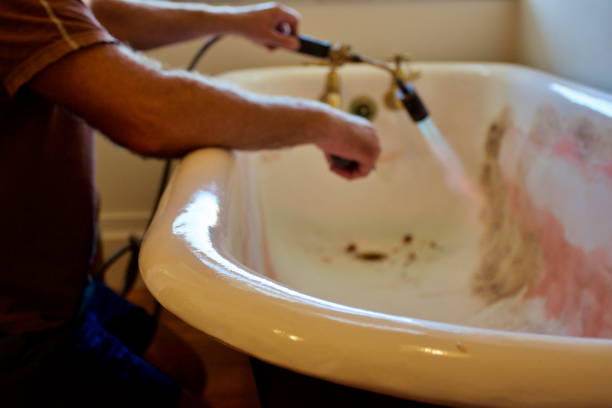Every hammer swing shapes more than wood; it shapes safety. Therefore, governments set rules that decide where DIY stops and licensed skill begins. Moreover, these rules are not red tape; they are life nets. However, many homeowners learn about them only after a stop work order arrives. Consequently, this section shows why and how the line protects you.
Permits Protect Safety
Initially, permits sound like paperwork. Yet each document forces a plan review that spots weak joists, undersized wires, or hidden gas leaks. The National Fire Protection Association reports 47,700 home fires a year start with faulty wiring. Therefore, inspectors serve as an additional layer of protection.
- Structural Stability—Plans confirm beams carry the load.
- Fire Prevention—Proper breakers, wire gauges, and GFCIs cut spark risks.
- Health Safeguards—Plumbing vents keep sewer gas outside, not under your roof.
Licensed Trades Defend Life
Meanwhile, some tasks remain off-limits even with a permit. Gas line work, whole-home rewiring, and asbestos removal demand state-issued licenses. Accordingly, pros carry insurance and training for lethal mistakes you cannot foresee. For example, one loose gas fitting can drop explosive levels of methane in minutes.
Codes Shield Communities
Likewise, building codes evolve after tragedies. After Hurricane Katrina, coastal cities raised flood elevations; many nations tightened cladding standards after Grenfell. Thus, your compliance will guard your neighbors as well as guests. Additionally, code records help future buyers trust that walls hide no dangers. Eventually, that trust converts to better resale value.
Consequently, skipping these steps triggers harsh penalties. Many Gulfport homeowners, for instance, have paid fines topping $10,000 and faced costly rework before utilities would reconnect power. Therefore, legality is not just a civic duty but a direct guard for your wallet, your comfort, and your family’s health.
Finally, understanding the “why” behind legality builds respect, not resentment. With that respect, you can choose DIY paths that stay safe and lawful while letting bigger jobs fund the experts. Plus, you avoid late-night worry over a knock from the code inspector ever again.
Post-It Fact
Illegal electrical work can void home insurance—share this and save a friend!
Home Projects That Require Permits
DIY feels empowering. Yet every city writes rules that protect lives and property. You must respect them. Which home improvement projects are illegal to DIY? hinges on three big triggers.
1. Permits and Codes
Building departments require work permits that change structure, power, water, or gas. Inspectors verify safety at each stage. Without permits, officials can issue stop-work orders and fines of $500 or more daily. They can also place a lien on your deed until you comply.
2. Licensed Trades
States require electricians, plumbers, and HVAC technicians to be licensed because their mistakes can injure people. Rewiring without a license can spark fires. U.S. crews still fight about 32,000 home electrical fires each year. Leaky gas lines created by amateur hands can explode. Even handling refrigerant without EPA certification breaks federal law.
3. Health and Hazard Laws
Projects that disturb asbestos insulation, lead paint, or large trees trigger additional rules. Agencies mandate certified abatement teams and arborist permits. Otherwise, you risk fines, lawsuits, and even criminal charges.
Value Highlights
- Stay safe: licensed traders follow a code that prevents shocks, leaks, and collapses.
- Save money: Permits cost far less than demolition or medical bills.
- Protect equity: Appraisers discount homes after spotting unpermitted work.
- Sleep well: Insurance cannot deny claims for properly documented upgrades.
The Emotional Bottom Line
You pour your heart and savings into a home. Therefore, imagine losing both because a hidden wire sparked at night. Suddenly, your proud DIY story becomes a court case. Regulations exist to keep that nightmare off the news and out of your life.
Quick Self-Check Flow
- Describe the job on paper.
- Call your local permitting desk.
- Ask if a licensed trade must sign off.
- Budget inspections from start to finish.
- Keep every receipt and permit in a safe file.
When you weigh these steps, you gain clarity. These rules are not red tape; they guide ambition safely. Spend ten minutes on permits today and skip years of painful, expensive repairs tomorrow.
Quick-Look Stat Bar
Stat: Why It Matters
- 47,700 house fires each year start with faulty wiring, highlighting the electrical danger
- Up to $11,000 fine for every day a permit violation continues underlines legal cost
- 19% of home closings face delays from inspection or permit issues, impacting resale timing
When we ask which home improvement projects are illegal to DIY? Hard numbers tell the story. First, faulty wiring ignites roughly 47,700 house fires yearly, endangering lives and property. Because electrical mistakes often spark tragedy, building codes require permits and licensed electricians. Therefore, skipping paperwork is not only illegal; it gambles with family safety.
Meanwhile, regulators protect communities with steep penalties. Under the Clean Water Act, officials may charge up to $11,000 daily for unpermitted construction that harms public resources. Local building departments mimic this model. As a result, a weekend shortcut can snowball into five-figure fines before you finish repainting the trim. That cost erases any DIY savings.
Finally, real estate data shows how hidden DIY work haunts resale plans. The National Association of Realtors finds that 19 percent of transactions stall in escrow because inspectors flag surprises, titles need fixes, or permits are missing. Every delay invites buyer doubt, mortgage rate shifts, and extra holding expenses. Consequently, unpermitted upgrades can slash profits or even kill the deal.
Moreover, these figures highlight opportunity. When permits stay current, insurers honor claims, buyers trust disclosures, and neighbors respect your timeline. Because the process remains transparent, you gain leverage if disputes arise. Documented improvements may even increase the value of a property during appraisal. Put plainly, legality multiplies return on investment.
For homeowners, the takeaway is simple yet powerful. Permit fees may feel annoying, yet they usually total less than two percent of a project budget. That small outlay buys legal security, smoother insurance renewals, and stronger resale value. Conversely, ignoring rules invites stress as you await a knock from code enforcement. Let these stats guide safe, confident progress. Because facts speak, heed them before you pick up the toolbox.
Why Some Projects Cross the Legal Line
Home projects feel harmless until the law steps in. Permits, trade licenses, and strict health codes create firm lines you must not cross. When homeowners skip these rules, cities can halt work, fine thousands, or even press charges. Therefore, knowing the limits keeps wallets, timelines, and safety intact. What home improvement projects are illegal to complete without professional help? The process begins with three essential pillars: permits, licensing, and health regulations.
Permits & Codes
Local codes protect structures, neighbors, and first responders. Thus, any work that changes load paths, wiring, plumbing, or HVAC usually needs a permit. In California, fees start at nearly $350 and rise to $1,500 if unpaid within 30 days. Moreover, some counties add daily penalties of $500 or more until papers are filed. Recently, Massachusetts set fines up to $1,000 per day for unpermitted builds.
- Structural alterations—removing walls, cutting joists, adding decks
- Electrical upgrades—new circuits, panel swaps, whole-home rewires
- Plumbing reroutes—moving supply or drain lines
- HVAC installs—duct changes, furnace swaps
Licensed Trades Required
Even with permits, the law often demands certified pros. Gas lines, asbestos removal, and refrigerant handling carry specialized risks. Therefore, state boards issue licenses to ensure skill and insurance coverage. If unlicensed work causes harm, prosecutors may file criminal charges. For example, violating asbestos rules under the Clean Air Act can bring five years in prison and heavy fines.
- Gas piping—leaks explode fast; most states require a master plumber or gas fitter
- Asbestos abatement—federal NESHAP rules mandate EPA-certified crews
- HVAC refrigerants—Section 608 of the Clean Air Act demands technician certification
Health and Safety Regulations
Certain materials threaten public health, so laws grow sharper. The EPA’s RRP Rule covers lead paint work in homes built before 1978. Consequently, fines can reach $37,500 per day for each infraction. Likewise, dumped asbestos recently triggered a $16,690 penalty in Queensland, highlighting global crackdowns.
- Lead paint sanding—generates toxic dust; certified renovators only
- Asbestos insulation—microscopic fibers scar lungs; regulated disposal required
- Mold-laden demolition—some states now classify large areas as hazardous waste
In short, permits guard the structure, licenses guard the craft, and health laws guard everyone’s lungs and water. When you respect all three, projects move forward confidently instead of court summons.
Projects You Can’t (Legally) Tackle Alone
Some upgrades tempt every handy homeowner. However, certain jobs don’t just void warranties—they break the law. Which home improvement projects are illegal to DIY? This section highlights trades that demand permits, licenses, and expert hands.
Electrical Systems (Faulty wiring kills six people weekly)
Careless wiring causes more sparks than fires, resulting in 305 fatalities annually. Inspectors require permits and a licensed electrician before any panel or house-circuit changes. Consequently, insurance can refuse claims after unpermitted work. Additionally, licensed installation shields resale value when inspectors review records.
- Panel upgrades
- Whole-home rewiring
Plumbing & Gas (CO poisoning kills 400+ Americans yearly)
Gas and water lines look simple yet fail silently. Moreover, plumbing codes mandate certified pros for new supply routes or appliance hookups. A missed step can flood rooms or leak explosive gas. Further, state boards can suspend DIY gas lines indefinitely until a pro certifies them.
- Moving supply lines
- Installing gas appliances
HVAC & Refrigerants (EPA fines reach $25k per day)
Technicians hold federal Section 608 cards for a reason. Releasing refrigerant or bypassing safety switches violates the Clean Air Act and invites heavy fines. Meanwhile, untrained hands can release refrigerant that burns skin instantly.
- Charging AC systems
Roofing & Structural Changes (Deck errors plague 59% of builds)
Removing a load-bearing wall or adding a rooftop layer alters a home’s skeleton. Therefore, cities issue stop-work orders if you skip permits. Also, a sagging span can cause home inspections to fail and slash appraisal figures.
- Removing load-bearing walls
- Full roof replacement
Hazardous Materials (OSHA fines $16k per violation)
Asbestos or lead removal releases toxic fibers. Even so, federal law demands licensed abatement teams with air monitoring. Furthermore, disposal rules require sealed bags and documented landfill drops.
- Asbestos insulation removal
- Lead-paint stripping
Tree Removal & Exterior Work (Illegal cuts can cost $10k per tree)
Municipal bylaws protect canopy and soil stability. Thus, cutting without a permit risks hefty fines and forced replanting. Neighbors may also file a lawsuit for erosion damage and lost shade.
- Cutting protected trees
- Major retaining walls
Ultimately, choose expertise and stay legally secure.
Real-World Consequences When DIY Turns Illegal
Skipping permits doesn’t save money; it causes years of legal and financial pain. Moreover, every city enforces penalties differently, yet the pattern remains brutal.
| State | Typical Fine Range for Unpermitted Work | Notable Example |
| California | $500–$5,000 per day | Humboldt couple faces $1 million in code fines |
| Florida | $500 per day + retro-permit fees | Counties issue daily penalties for ongoing jobs |
| Massachusetts | Up to $100,000 per violation | Brookline house razed without permit; contractor fined |
Fines & Stop-Work Orders
- Cities post red “STOP-WORK” notices when anyone builds without approval.
- Inspectors can lock the site until fees and permits clear.
- Daily fines grow fast; some districts also place tax liens on homes.
Insurance Denials
- Insurers often refuse fire or flood claims tied to unpermitted wiring or plumbing.
- Even approved claims can drop coverage later, raising premiums or forcing cancellation.
Forced Demolition
- If work endangers safety, officials can order total removal.
- After tearing it down illegally, one Brookline contractor had to dismantle a whole residence.
- Counties also demand homeowners rip out kitchens or decks that hide code violations.
Injury & Liability
- Faulty DIY stairs, decks, or wiring can injure guests; lawsuits target the homeowner.
- Courts recently awarded $930k after unsafe site conditions hurt a visitor.
Because these hits arrive long after the project feels “done,” they drain savings, stall sales, and ruin peace of mind. Therefore, please consult the building office initially, engage licensed professionals when necessary, and retain all permit receipts. That way, you protect your health, resale value, and—most importantly—your freedom from crushing fines.
Stay on the Right Side—Your 5-Step Legality Check.
Homeowners often ask, “How do I avoid fines and heartache?” This step-by-step guide turns that worry into calm action. By following each checkpoint, you keep projects safe, legal, and stress-free. Moreover, you protect your budget while preserving your peace of mind.
- Confirm if permits are required.
Visit your city’s building portal or call the permit desk. Even small structural changes may need approval. Since regulations differ from one block to another, it is crucial to confirm before proceeding. Consequently, you avoid costly stop-work orders and delays.
2. Verify trades that need licensed pros.
List every task: wiring, gas plumbing, roofing, or HVAC. Then, check state licensing boards. Many jurisdictions forbid DIY gas or major electrical work. Therefore, hiring certified experts shields you from liability. In addition, insurers stay happy when pros handle high-risk trades.
3. Budget time for inspections
Permits mean inspections. Schedule them early and pencil the buffer days into your project timeline. This simple habit prevents frustration when inspectors request fixes. Furthermore, it shows buyers that your upgrade passed every test, preserving the resale value.
4. Keep documentation and photos.
Store digital copies of permits, receipts, and inspection reports throughout the project. While you work, snap clear photos of open walls and buried lines. Later, these images prove compliance and simplify future repairs. Besides, organized records calm nervous buyers and appraisers.
5. File for retroactive permits if work is already done
Maybe you inherited unpermitted changes. Don’t panic. Instead, visit the building office and apply for an “as-built” permit. Inspectors will review the existing work, suggest fixes, and stamp approval once everything meets the code. Thus, you erase hidden risks before they bite you. Moreover, mortgage lenders appreciate the transparency.
Because you now follow these five checkpoints, you answer the vital question— “Which “home improvement projects are illegal to DIY?”—with confidence instead of doubt. Above all, this legality check saves money, ensures safety, and keeps your dream home strong for decades.
Safe DIY Alternatives That Scratch the Reno Itch
DIY still thrills many homeowners. Yet you must stay legal and safe. Therefore, choose low-risk projects that still refresh a room. You boost style without flirting with inspectors when you tackle the ideas below. Which home improvement projects are illegal to DIY? will no longer haunt your weekend plans because these tasks sit comfortably on the “yes, you can” list:
- Painting & accent walls
- Backsplash tiling
- Fixture swaps (non-wired)
- Landscaping & décor builds
Grab a roller and change the wall color. Because paint is surface-level, permits are never required. Moreover, modern low-VOC formulas dry fast, so you enjoy a fresh vibe by sundown. Besides, an accent wall lets you test bold hues without overwhelming the space. Consequently, you build confidence while raising perceived property value.
Consider a peel-and-stick backsplash. You can cut the panels with scissors, eliminating the need for a wet saw. Furthermore, they resist steam and stains, giving kitchens an instant lift. As a result, you protect drywall from splashes and impress guests with a tidy upgrade.
Meanwhile, swap tired knobs, handles, and non-wired light fixtures. Because the wiring stays untouched, code officials remain silent. Additionally, quick-change fixtures sharpen a room’s theme—farmhouse, industrial, or coastal—without costly remodels. Still, shut off the breaker as a safety habit, reinforcing a prudent DIY culture.
Step outside beyond four walls. Simple planter boxes, mulch beds, or gravel paths transform curb appeal. Raised-bed gardens boost nutrition and invite pollinators. Even a modest seating nook fosters evening relaxation. Therefore, you enrich daily life while sidestepping zoning headaches.
Yet benefits extend past beauty. Hands-on projects trim labor costs, keep skills sharp, and release creative energy. More importantly, they fill the “key advantages bucket”: you gain pride, save money, and learn new abilities—without risking fines or insurance woes. Finally, because these tasks remain legal everywhere, you sleep easy knowing inspectors will focus elsewhere. In short, smart choices let you enjoy the DIY rush, stay within the law, and keep your home’s future bright.
DIY Decision Flowchart: Choose the Lawful Route
Your plan looks bold, yet you still feel unsure. This flowchart removes the doubt and keeps you safe. Every arrow shows the shortest way toward legal success and away from costly mistakes.
- Spark the Idea
You picture a brighter kitchen or a sturdy deck. First, write the dream in one line. Keep it clear.
- Check the Code Book
Next, open your city’s online permit portal. Then, type the project name. If it shows “Permit Required,” circle that note. As rules can differ, please ensure you complete this early check.
- Permit Decision Box
- Yes—Permit Needed
Therefore, move straight to the next box.
- No—Permit Free
You can often proceed yet still read local guidelines. However, hidden limits may apply.
- Is certification mandatory?
Ask, “Does the work touch gas, main wiring, or structural frames?”
- If the answer is yes, only licensed professionals are allowed to handle it. Thus, hire one and relax.
- If not, the door might open for you.
- Skill and Safety Check
Be brutally honest now. Because safety sits first, list the risks.
- Fire?
- Flood?
- Collapse?
If any risk feels high, choose a pro. So you protect family and value.
- Budget Reality
Add material costs, tool rentals, and inspection fees. Even so, include fines you could face if you break the code. When pro fees match that total, hiring becomes wiser.
- Timeline Gauge
Could you please inquire about the duration for permits, inspections, and fixes? Since delays often hurt resale, time weighs against money.
- The Final Arrow
- DIY: You hold the permit, meet the code, and own the skills—proceed with joy.
- Hire Pro: Licensing, risk, or time gaps push you to outsource. Therefore, call a certified craftsperson.
What You Gain
Because this flowchart guides each big choice, you:
- Avoid fines and stop-work orders
- Protect the resale value and insurance coverage
- Finish projects faster with zero legal stress
Use it whenever you wonder, “Which home improvement projects are illegal to DIY?” This simple map lets you act confidently, stay legal, and sleep well.
Build Your Dream—Legally & Safely
Your home should lift your spirit, not raise your stress. Therefore, every plan should be honored with legal care. First, remember that codes exist to guard lives and savings. Consequently, when you check permits before drilling, you protect your family and property value. Moreover, licensed experts bring training that no video can match; they spot hidden hazards fast and fix them for good.
Yet confidence still is yours. Knowing which tasks are legally permissible allows you to make informed decisions, such as painting the nursery yourself or hiring an electrician for a panel upgrade. Thus, smart decisions let you enjoy the pride of improvement without fear of fines, injuries, or insurance woes.
However, laws change town by town. So consult local inspectors, pull the right paperwork, and keep every receipt. In addition, schedule required inspections on time; fresh signatures today save headaches at resale tomorrow.
Finally, turn knowledge into action. With clear steps and expert help, you will build, remodel, and thrive—proud of each nail placed and sure of every legal box ticked.
FAQ Accordion
Q1: Can I replace a light fixture myself?
A1: Usually, yes, when amperage and box ratings match. Always cut power and, when required, file a quick “minor electrical” permit.
Q2: Do I need a permit to build a deck?
A2: Yes, if it is higher than 30 inches, attaches to the house, or exceeds 200 sq. ft.
Q3: Who checks gas line work?
A3: Licensed plumbers with gas certification pull the permit, and city inspectors sign off before you turn the valve.

















Leave a comment